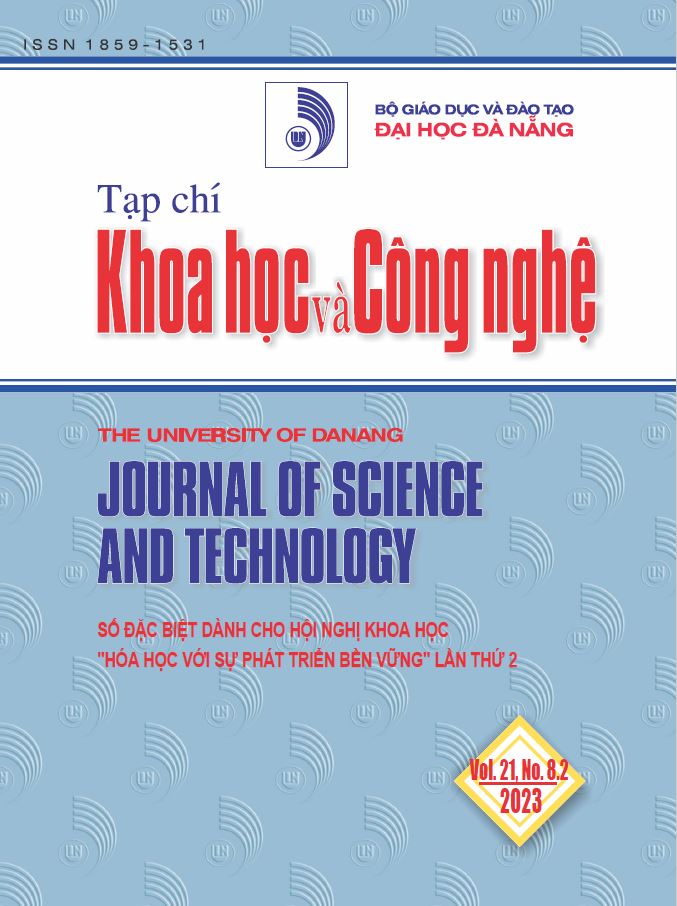Sàng lọc in silico các hợp chất hữu cơ phân lập từ cây chân danh hoa thưa (Euonymus laxiflorus Champ.) theo hướng điều trị ung thư
 Tóm tắt: 539
Tóm tắt: 539
 |
|  PDF: 532
PDF: 532 
##plugins.themes.academic_pro.article.main##
Author
-
Nguyễn Minh ThôngTrường Đại học Sư phạm - Đại học Đà Nẵng, Đà Nẵng, Việt NamMai Văn BảyTrường Đại học Sư phạm - Đại học Đà Nẵng, Đà Nẵng, Việt NamTrần Đức MạnhTrường Đại học Sư phạm - Đại học Đà Nẵng, Đà Nẵng, Việt NamPhan Tứ QuýTrường Đại học Tây Nguyên, Việt NamVõ Văn QuânTrường Đại học Sư phạm Kỹ thuật - Đại học Đà Nẵng, Đà Nẵng, Việt NamĐinh Tiến HiếuTrung tâm y tế huyện Cư M'gar, Việt NamPhạm Cẩm NamTrường Đại học Bách khoa - Đại học Đà Nẵng, Đà Nẵng, Việt Nam
Từ khóa:
Tóm tắt
Trong bài báo này, 20 hợp chất có nguồn gốc từ cây chân danh hoa thưa (Euonymus laxiflorus Champ.) đã được sàng lọc để tìm các hợp chất tiềm năng phát triển thuốc điều trị bệnh ung bằng phương pháp in silico. Kết quả cho thấy 7/20 chất có đặc tính giống thuốc thỏa mãn các tiêu chí của tất cả các mô hình Lipinski, Egan, Veber, khả năng hấp thu đường uống, PAINS và có đặc tính dược động học (ADMET) tốt. Bên cạnh đó, dữ liệu phân tích docking phân tử cho thấy rằng các hợp chất 3, 6, 13, 18 và 19 gắn kết với protein TYMS tốt hơn so với thuốc thương mại FLU thông qua các tương tác với các amino acid quan trọng là Phe225, Leu221 và Ile108. Vì vậy, tiềm năng của các hợp chất này có thể phát triển như các thuốc ức chế enzyme TYMS hướng điều trị bệnh ung thư.
Tài liệu tham khảo
-
[1] L. Siegel, K. D. Miller, and A. Jemal, "Cancer statistics, 2016", CA Cancer J Clin, vol. 66, pp. 7-30, 2016.
[2] T D. Jr and E. Chu, "A history of cancer chemotherapy", Cancer Res, vol. 68, pp. 8643-53, 2008.
[3] G. Rose, M. P. Farrell, and J. C. Schmitz, "Thymidylate synthase: a critical target for cancer chemotherapy", Clin Colorectal Cancer, vol. 1, pp. 220-9, 2002.
[4] L. Lehman, "Future potential of thymidylate synthase inhibitors in cancer therapy", Expert Opin Investig Drugs, vol. 11, pp. 1775-87, 2002.
[5] Papamichael, "The use of thymidylate synthase inhibitors in the treatment of advanced colorectal cancer: current status", Stem Cells, vol. 18, pp. 166-75, 2000.
[6] P. Costi et al., "Structure-based studies on species-specific inhibition of thymidylate synthase", Biochim Biophys Acta, vol. 1587, no. 2-3, pp. 206-14, 2002.
[7] -W. Chin, M. J Balunas, H. B. Chai, and A D. Kinghorn, "Drug discovery from natural sources", AAPS J, vol. 8, no. 2, p. E239-53 2006.
[8] Gordaliza, "Natural products as leads to anticancer drugs", Clin Transl Oncol, vol. 9, pp. 767-76, 2007.
[9] B. Nguyen et al., "Bioactivity-Guided Purification of Novel Herbal Antioxidant and Anti-NO Compounds from Euonymus laxiflorus Champ", Molecules, vol. 24, no. 1, p. 120, 2018.
[10] -V. Nguyen, N.-H. Nguyen, S.-L. Wang, V. B. Nguyen, and A. D. Nguyen, "Free radical scavenging and antidiabetic activities of Euonymus laxiflorus Champ. extract", Research on Chemical Intermediates, vol. 43, no. 10, pp. 5615-5624, 2017.
[11] Nguyen Van Bon et al., "Isolation and identification of novel α-amylase inhibitors from Euonymus laxiflorus Champ", Research on Chemical Intermediates, vol. 44, pp. 1411-1424, 2017.
[12] B. Nguyen et al., "Novel Potent Hypoglycemic Compounds from Euonymus laxiflorus Champ. and Their Effect on Reducing Plasma Glucose in an ICR Mouse Model", Molecules, vol. 23, no. 8, 2018,
[13] J. Frisch, et al., Gaussian 09, Revision A.02, 2009: Gaussian, Inc., Wallingford CT.
[14] Daina, O. Michielin, and V. Zoete, "SwissADME: a free web tool to evaluate pharmacokinetics, drug-likeness and medicinal chemistry friendliness of small molecules", Sci Rep, vol. 7, p. 42717, 2017.
[15] A. Lipinski, "Drug-like properties and the causes of poor solubility and poor permeability", J Pharmacol Toxicol Methods, vol. 44, pp. 235-49, 2000.
[16] J. Egan, K. M. Merz, Jr., and J. J. Baldwin, "Prediction of drug absorption using multivariate statistics", J Med Chem, vol. 43, pp. 3867-77, 2000.
[17] F. Veber et al., "Molecular properties that influence the oral bioavailability of drug candidates", J Med Chem, vol. 45, pp. 2615-23, 2002.
[18] E. Pires, T. L. Blundell, and D. B. Ascher, "pkCSM: Predicting Small-Molecule Pharmacokinetic and Toxicity Properties Using Graph-Based Signatures", J Med Chem, vol. 58, pp. 4066-72, 2015.
[19] MOE, The Molecular Operating Environment: software available from Chemical Computing Group Inc., 1010 Sherbrooke Street West, Suite 910, Montreal, Canada H3A 2R7.
[20] Biovia Dassault Systèmes, Discovery studio modeling environment, Dassault Systemes: San Diego, 2015.
[21] Kairys et al., "Toward the design of mutation-resistant enzyme inhibitors: further evaluation of the substrate envelope hypothesis", Chem Biol Drug Des, vol. 74, pp. 234-45, 2009.
[22] M. El-Naggar et al., "Synthesis, characterization and molecular docking studies of thiouracil derivatives as potent thymidylate synthase inhibitors and potential anticancer agents", Mol Divers, vol. 21, pp. 967-983, 2017.
[23] X.-C. Li et al., "Influence of bromoethyl group on biological activity of 5-fluorouracil prodrug: Insights from X-ray crystallography and molecular docking", Journal of Molecular Structure, vol. 1027, pp. 104-110, 2012.



